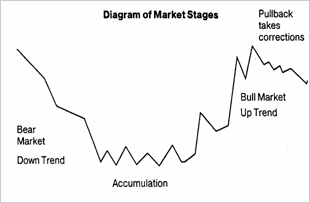MARKET STAGES
Traditionally markets move from Bull markets to Sideways markets to Bear markets. They move from Bear to Sideways to Bull. People however tend to forget the sideways market stage and assume that markets move from Bear to Bull, to Bear. The only markets that do in fact move from Bull to Bear are the exceptions and not the rule Ч they are parabolic markets and are usually characterised by thin trading volumes. Traditionally speaking, the market stages can be summarized as follows: Markets accumulate Ч go sideways at the end of a down trend Markets then trend up, trending up they have a correction or a pause Markets then climax or peak Markets accumulate (distribution Ч sideways movement at the top) Markets trend down
Vocabulary
0:
accordingly - соответственно
au
to'counter Ч выдвигать контраргумент
time frames Ч временные рамки
i
to anticipate Ч предвосхищать
e
exception - исключение

о volume
Ч объем
to apply
Ч примен€ть, использовать
(to be) due
Ч ожидаемый, обусловленный
ei
A trader does not sell just because the market has been in an up trend for a long time and a change is due. Before you sell, you at least need to see a sideways move in the market. Technical Analysis is applied to markets because: 1. Markets have stages. 2. Within the stages, there are behavioural characteristics. 3. Within the behavioural characteristics, you have specific patterns. There exist three types of market trends: 1. Up Trend 2. Down Trend 3. No TrendЧCongestion
behavioural
i sophisticated
э 'option
Ч поведенческий Ч сложный Ч опцион
